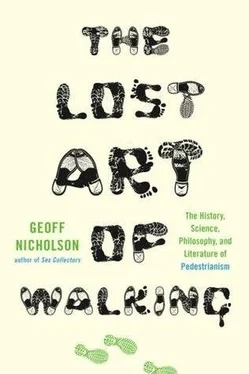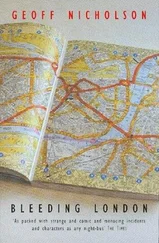So, by her own account, Ffyona Campbell rode in the truck with Noel for about a thousand miles of the journey, appearing on foot only at the beginning and end of the day when people were looking. The fact that she was able to get away with this certainly suggests that the American media spotlight wasn’t trained on her with any great brightness.
Later she terminated the pregnancy and continued walking around the world. Only after she’d walked another 16,000 miles or so did the guilt really hit her. By her own account she became a depressive and a user of heroin. Then she tried to exorcise her guilt by telling all.
The scorn and contempt poured upon her by the English press in the wake of her confession was staggering. The London Evening Standard called her ‘a self-serving ninny’, which was the least of it. Campbell seems to have been surprised — I can’t think why. To be conned is one thing; to have the confidence trickster then turn around and point out how gullible you are is simply unbearable. Revenge is called for. And naturally, once someone tells you they were lying about a certain part of their story, there’s no reason to believe they are telling the truth about any of the rest. That record-breaking Australian walk suddenly starts to look suspect. Perhaps the confession itself is just another deception. Maybe Campbell really is a great walker, who told one lie and later suffered and made up for it. But by what means can we now tell whether or not that’s the case?
The great contemporary British explorer Sir Ranulph Fiennes once called Campbell ‘the greatest walker of them all’. I wonder what he calls her now. I also suspect that even at the time he was being uncommonly generous, since by Fiennes’s standards very few people in the world are real walkers at all. Fiennes was the first man to cross the whole of Antarctica on foot, and in 2000 he attempted, and failed, to do a solo walk to the North Pole, losing his fingertips as a result. He cut them off himself because he was impatient with the doctors who were treating him.
♦
Campbell’s title On Foot Through Africa echoes, accidentally I think, that of a memoir written by James Augustus Grant, a Victorian explorer of equatorial Africa, and sometime companion of John Speke in his search for the source of the White Nile. Grant called his book, published in 1864, A Walk Across Africa , but in fact he by no means walked all the way across. For five months he had an excruciating condition in his right leg, what is now thought to have been Buruli ulcer, that caused abscesses, pain, swelling, and foul discharge. He could barely straighten his leg, much less walk.
Eventually he was carried on a stretcher from the kingdom of Karague in Abyssinia to Uganda, where he was to meet up with Speke. Grant recounts that the stretcher bearers, members of the Waganda tribe, conveyed him at shoulder height, at six miles an hour, ‘jostling and paining my limb unmercifully’.
Speke himself was no more merciful when Grant joined him. He was about to set off into the Ugandan interior and wanted to know if Grant was capable of making a ‘flying march’ of twenty miles a day. Grant knew he wasn’t, and Speke knew it, too. Speke traveled without him and therefore didn’t have to share the glory of being the first white man ever to see the source of the White Nile.
The title of Grant’s book may then seem at best an exaggeration, but given that Grant himself is the one who reveals the fact of his incapacity it would be churlish to object, especially since it was inspired by Lord Palmerston, who greeted Grant on his return from Africa with the words ‘You have had a long walk’. Call it poetic license.
It certainly seems more forgivable than the conduct of Mao Zedong during the Long March of 1934–1935. As 90,000 Red Army troops retreated north from Jiangxi to Shanxi province, dwindling by 90 percent along the way, Mao was one of only two people who did no marching, or walking, whatsoever. (The other was Otto Braun, a Prussian advisor, and an ideological opponent of Mao.) According to Dick Wilson’s The Long March , Mao:
‘would never march, and either rode a horse along the route or else, if it were a long stretch, would be carried on a wooden litter by four carriers’.
The Long March remains one of the great national myths of China. Writing in late 1935, Mao declared, ‘The Long March is the first of its kind. It is a manifesto, a propaganda force, a seeding machine’. Well, only up to a point.
It wasn’t until 2002 that anyone tried to repeat the exercise. In that year two Englishmen, Ed Jocelyn and Andy McEwan, retraced the steps of the Long March, and although their, and apparently everyone else’s, knowledge of the route depended on educated guesswork, they calculated that the march was some 4,000 kilometers shorter than had generally been claimed. The Long March is said to have been 10,000 kilometers long (a nice round figure), but Jocelyn and McEwan only clocked 6,000. They covered the route in 370 days — the Red Army took 384.
The two Englishmen were not iconoclasts, and they didn’t set out to disprove or debunk the myth. Nevertheless, they’ve been denounced by Chinese officials. Gao Zhiyin, a spokesman for the Yan’an Foreign Affairs Department, is quoted as saying, ‘Can they change history? The whole world acknowledges these facts’. That’s all right then. Print the legend.
♦
Which brings me to one of the world’s most enigmatic (and let’s face it, perfectly silly) walkers, an English playboy, womanizer, and gambler named Harry Bensley. The story, and it comes in several versions, is that on January 1, 1908, Bensley set off from Trafalgar Square in London wearing a four-and-a-half-pound iron mask in order to test whether or not a man could walk around the world without being ‘identified’. One version has John Pierpont Morgan and Lord Lonsdale debating the matter at the London Sporting Club, which was briefly the name of a boxing venue in Manhattan, though there were surely other places with the same name. Lonsdale said it could be done — Morgan said it couldn’t. Bensley overheard the debate, and being a sporting man, offered to demonstrate that it could. He stood to win £21,000 of Morgan’s money if he succeeded. Another version has Bensley in enormous debt to the two men and being forced to do the walk as a forfeit.
There are problems with both these versions, and either way the whole proposition is surely an absurd one, and not much of a bet, since the matter of identification depends so largely on who the man is and precisely what parts of the world he walks around. But the real issue is the wearing of the mask, which seems to be a cheat in a couple of ways. Yes, in one way it prevents the wearer’s being recognized, but in another way it doesn’t. After a while people might well see him walking down the street and say, ‘There goes that guy in the iron mask’, which is surely a sort of recognition. More crucially it means nobody could ever be certain it was actually Bensley inside the mask and doing the walking. Perhaps this was his intention.
But even assuming there was a bet to be made, would anyone, however sporting, really be inclined to give up several years of his life to travel around the world wearing a mask, even for that amount of money? If Bensley was doing it as a forfeit, that makes Morgan and Lonsdale a couple of very creepy guys indeed. Both versions do, of course, suggest that Bensley might have been thoroughly broke.
The conditions laid down for the walk were extremely strict and occasionally bizarre, and could be read in a pamphlet that Bensley sold while traveling in order to finance himself. They included details of how he was to dress, how much money he was allowed to spend (very little, although if he was broke this wouldn’t have been much of an issue). He was to push a baby carriage in front of him, not a particularly onerous condition since he could carry his belongings in it, but far more problematically he had to find himself a wife en route, one who had never seen his face.
Читать дальше












